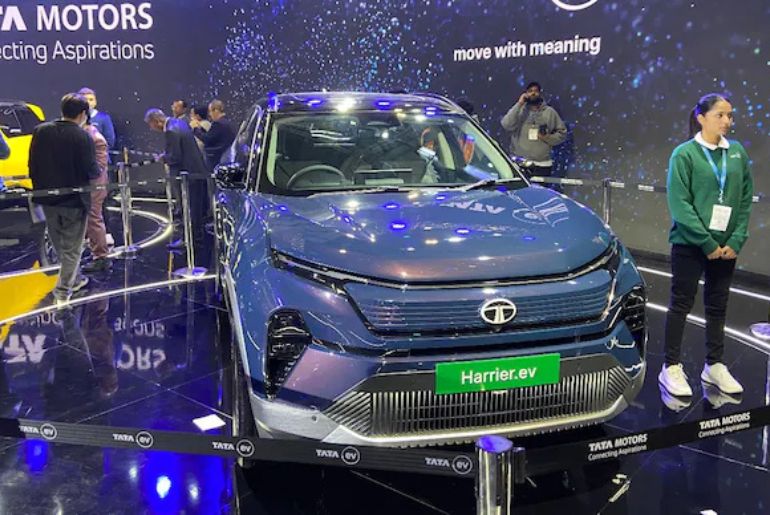Tata Motors plans to further expand its line of electric vehicles in India with the June 3 debut of the all-electric Harrier.ev, which is expected to have a real-world range of about 500 kilometres.
On June 3, Tata plans to introduce the Tata Harrier’s electric version. At the 2025 Bharat Mobility Global Expo, the Harrier.ev was on display. The Harrier EV is a daring competitor in the electric SUV market with to its quad-wheel-drive (QWD) dual-motor arrangement, a real-world range of about 500 km, and a host of high-end features. It is based on the ActiveV+ architecture. Models like the Mahindra XEV 9e will face competition from the Harrier EV.
The Tata Harrier EV stands out thanks to its aggressive and tough look. The EV has a modified grille and bumper for a unique look, even though the DRLs and headlamps are similar to those of the internal combustion engine (ICE) version. Its exact edges, clean surfaces, and crisp lines define its external styling. Together with specially designed turbine blade alloy wheels, a continuous LED daytime running light (DRL) strip with expressive lighting elements improves the vehicle’s aerodynamic performance and futuristic appearance. The Harrier EV is a powerful and elegant vehicle, built on a monocoque chassis that was inspired by the Land Rover D8-based OMEGA platform and created in partnership with Jaguar Land Rover.
With a dual-motor arrangement that offers quad-wheel drive and a maximum torque of 500 Nm, the Harrier EV was designed with both power and efficiency in mind. According to Vivek Srivatsa, Chief Commercial Officer at Tata Passenger Electric Mobility (TPEM), the SUV is designed to reduce range anxiety on longer trips by achieving a real-world driving range of roughly 500 km on a single charge. The precise battery parameters are yet unknown.
With its Open Collaboration 2.0 programme, Tata Motors is bolstering the ecosystem for electric vehicles in India. By 2027, the firm wants to increase the number of public charging stations to 400,000, working with oil marketing companies (OMCs) and charge point operators (CPOs). A classic “chicken-and-egg” conundrum confronts India’s charging network, but rising EV usage is propelling the expansion of private charging networks, opening the door to a sustainable EV future, according to Srivatsa.
Since introducing the Nexon.ev in 2020, Tata Passenger Electric Mobility has sold more than 200,000 EVs, maintaining its position as the industry leader in India. In addition to the Tiago.ev, Tigor.ev, Punch.ev, Nexon.ev, and Curvv.ev, Tata’s expanding EV lineup will now include the Harrier EV and the soon-to-be Sierra.ev.

